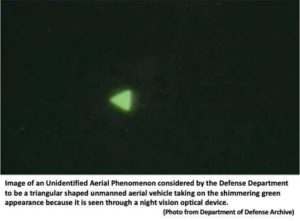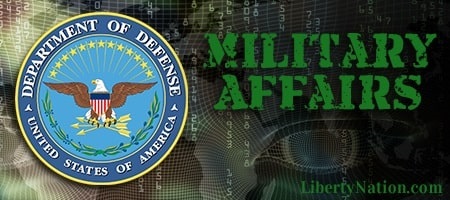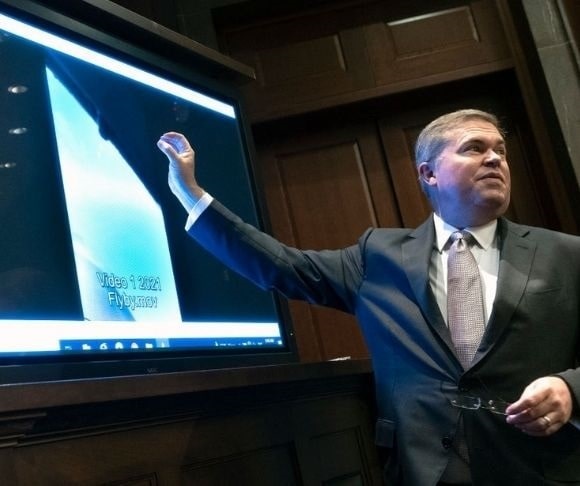On May 17, Congress questioned Pentagon officials on unidentified aerial phenomena (UAP). “More than 50 years ago, the US Government ended Project Blue Book, an effort to catalog and understand sightings of objects in the air that could not otherwise be explained,” explained Representative Andre Carson (D-IN), chairman of the subcommittee on counterterrorism, counterintelligence, and counterproliferation. “In 2017, we learned for the first time the Department of Defense had quietly restarted a similar organization tracking what we now call unidentified aerial phenomena.” Called the AOIMSG (Airborne Object Identification and Management Synchronization Group), it fulfills the purpose of determining the level of national security threat the UAPs represent. Carson added, “This hearing is about examining steps that the Pentagon can take to reduce the stigma surrounding reporting by military pilots and by civilian pilots.”
Previously, government agencies treated sightings with skepticism and ridicule, often dismissive of UAP reports. Consequently, military pilots were highly reluctant to make such observations known. However, Congress is now intent on making the analysis of such viewings a national security priority. “UAPs are unexplained. It’s true. But they are real. They need to be investigated, and any threats they pose need to be mitigated,” Carson emphasized.
The chairman Introduced witnesses Ronald Moultrie, undersecretary of defense for intelligence and security and director of AOIMSG, and Scott Bray, the Unidentified Aerial Phenomena Task Force leader and deputy director of naval intelligence. Moultrie defined UAP as “airborne objects that when encountered cannot be immediately identified,” adding that “it is the department’s contention that by combining appropriately structured collected data with rigorous scientific analysis, any object we encounter can likely be isolated, characterized, identified, and, if necessary, mitigated.” Military pilots have encountered UAP that “pose potential flight safety and general security risks, so they must be taken seriously. The Department of Defense is “committed to a focused effort to determine their origins.” Moultrie assured efforts would include “the thorough examination of adversarial platforms and potential breakthrough technology, US Government or commercial platforms, allied or partner’s systems, and other natural phenomena.”
Moultrie agreed with Carson about the stigma attached to reporting UAP and promised to establish a standardized data-gathering process to eliminate the skepticism. UAP reporting will be a “mission imperative.”
 From a national security perspective, Representative Rick Crawford (R-AR) warned there can be no intelligence failure in detecting a threat from unknown advances in technology manifested as UAP. The intelligence community has a duty to prevent potential “adversaries like Russia and China from surprising us with unforeseen new technologies.” Particularly important to Crawford was what the Pentagon has been “doing to determine if any UAP are new technologies, or not.”
From a national security perspective, Representative Rick Crawford (R-AR) warned there can be no intelligence failure in detecting a threat from unknown advances in technology manifested as UAP. The intelligence community has a duty to prevent potential “adversaries like Russia and China from surprising us with unforeseen new technologies.” Particularly important to Crawford was what the Pentagon has been “doing to determine if any UAP are new technologies, or not.”
On that topic, Bray’s opening statement provided a tutorial UAP observations, which fall into five categories: (1) airborne clutter, (2) natural atmospheric phenomena, (3) US industry or governmental programs, (4) foreign adversaries’ systems, and (5) other observations that allow for a whole new “bin of difficult cases including potential surprise technological discoveries.” Bray showed the subcommittee newly declassified videos and images of UAP.
Since last June’s Office of the Director of National Intelligence report on UAP, more than 400 new images have been collected. Unfortunately, detailed and accurate analysis of sightings is hampered by a “lack of high-quality data and reporting.” Moultrie explained later in the hearing the AOIMSG is attempting to understand “what may just be natural phenomena; two, what may be sensor phenomenology, or something happening with sensors; and, three, what may be legitimate counterintelligence threats to bases we have or installations, or security threats to our platforms.”
 Moultrie inserted a moment of levity when he revealed he was a science fiction fan and had attended science fiction conventions. He would not admit if he went in costume.
Moultrie inserted a moment of levity when he revealed he was a science fiction fan and had attended science fiction conventions. He would not admit if he went in costume.
The committee’s questions and the witnesses’ responses portrayed a thoughtful and intelligent treatment of the UAP issue. The Defense Department endeavored to provide all interested stakeholders transparency while not jeopardizing technical intelligence-gathering means. The classified portion of the witness testimony followed and was not open to the public.
Moultrie and Bray gave every indication they were dedicated to remedying the perception that the government treats UAP with skepticism and disinterest. The public did hear an honest, clearly articulated effort by the Defense Department to shed light on UAP.
The views expressed are those of the author and not of any other affiliation.




